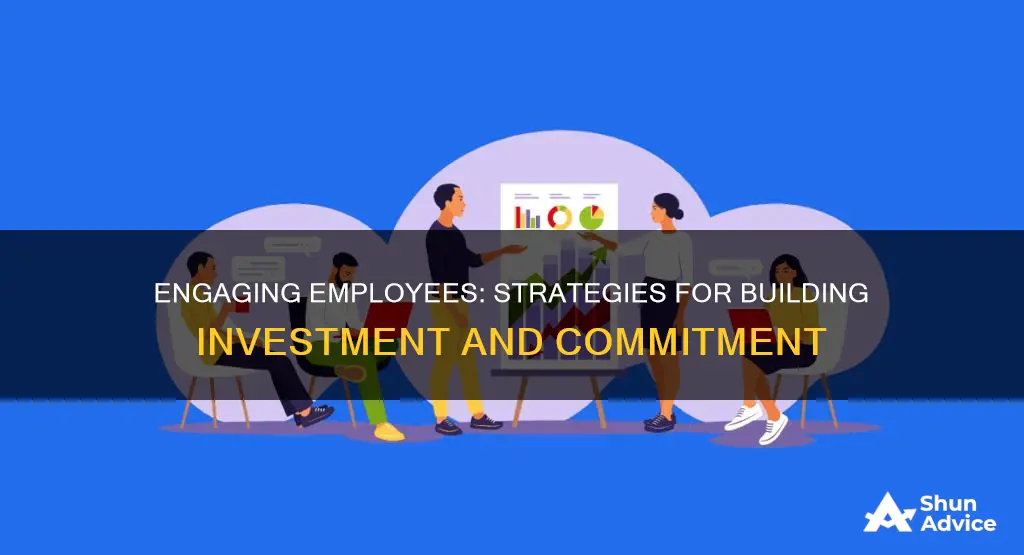
Employees are the face of a company, and their work and interactions with customers are crucial to its success. For employees to perform at their highest levels, they need to be emotionally invested in their work. While employers cannot guarantee that their employees will invest themselves in the company in the same way, there are several practical things they can do to help their employees become more invested. This includes creating a team environment, sharing the company's dreams and goals, praising good work, organising team-building events, providing benefits, communicating clearly, cultivating a positive work environment, and investing in employee training.
What You'll Learn

Encourage team-building exercises
Team-building exercises are a great way to invest in your employees and make them feel valued. Here are some ideas for team-building exercises to encourage and inspire your workforce:
- Icebreakers: These are a great way to start meetings and get everyone talking and feeling comfortable. They can be as simple as asking everyone to share something about their morning routine while working from home or their proudest professional achievement. You could also try the game "Two Truths and a Lie", where participants share two truths and one lie about themselves, and others have to guess which is which.
- Quick team-building activities: These are perfect for energising your team and improving communication. For example, in "Sync Claps", your team stands in a circle and claps in unison, trying to speed up without breaking the rhythm. Or, in "Count Up", your team must count to 20 with their eyes closed, ensuring that only one person speaks at a time.
- Fun team-building activities: These can help to inject some joy and laughter into your team, and are especially useful if your team has been going through a challenging period. For instance, "Rock, Paper, Scissors" can be played as a tournament, with losing players becoming fans of the winners and cheering them on. Or, "Build-a-Shake" involves creating a secret handshake with a partner and then teaching it to the rest of the group.
- Physical team-building activities: These get your team moving and are a great way to improve collaboration and creative thinking. For example, in "Blind Square", your team must work together to form a perfect square while blindfolded, using a length of rope. Or, in "Crocodile River", your team must physically support each other to move across a wide outdoor space together.
- Problem-solving team-building activities: These activities encourage your team to step out of their comfort zone and work together to find solutions. For instance, in "Marshmallow Challenge", small groups must build the tallest freestanding structure they can using spaghetti, tape, string and a marshmallow.
- Trust-building team-building activities: These activities create an environment where team members feel safe and supported. For example, in "The Personal Shield", team members draw a "shield" with positive qualities about themselves, which they then share with the group. Or, in "Team Appreciation Circle", team members take turns receiving specific appreciations or positive feedback from the rest of the group.
Team-building exercises are a fantastic way to bring your team together and improve collaboration and communication. They can also be a lot of fun!
Equilibrium Economics: Savings-Investment Identity
You may want to see also

Provide development opportunities
Providing development opportunities for employees is one of the most important investments a company can make. By offering opportunities for growth, businesses can improve employee retention and productivity while reducing training costs. Here are some ways to provide development opportunities and foster a culture of learning:
Individual Development Plans (IDPs)
IDPs are a powerful tool to help employees set and achieve their short- and long-term goals. These plans empower employees to assess their current situation, envision their future, and create a roadmap to get there. Managers should hold monthly check-ins with their direct reports to track progress and provide direction. This consistent guidance helps employees hold themselves accountable and make continuous improvements.
On-the-Job Training and Mentorship
On-the-job training is a valuable way to develop employees' skills and knowledge. Mentorship programs can also be implemented, where experienced employees or leaders within the company guide and support less tenured staff. Mentorship provides an opportunity for protégés to learn from their mentors' expertise and grow their careers.
Online Learning and Workshops
Offering online courses, workshops, and conferences can enhance employees' skill sets and keep them up-to-date with industry trends. These learning opportunities can be provided in addition to, or in conjunction with, on-the-job training to create a well-rounded development program.
External Training
Sending employees to seminars, workshops, or providing access to online learning tools are great ways to expose them to new ideas and best practices in the industry. This type of external training not only benefits the individual but can also bring fresh perspectives and innovations to the company.
Cross-Departmental Movement
Allowing employees to move laterally within the company can help them pursue their passions and discover their strengths. This approach promotes internal talent development and ensures employees remain engaged and motivated, leading to higher retention rates.
By implementing these development strategies, companies can create a skilled, adaptable, and satisfied workforce that is equipped to meet the evolving demands of the business.
Strategic Investment Management: A Guide to Success
You may want to see also

Offer benefits and perks
Offering benefits and perks to employees is a great way to make them feel valued and invested in the company. Here are some ideas to consider:
Healthcare and insurance
Consider providing health insurance or other benefits such as dental, vision, or life insurance. This not only shows your employees that you care about their well-being but also helps attract and retain talent. According to a survey, better benefits were one of the top reasons millennials look for new jobs.
Wellness programs
Focus on creating a healthier work environment by implementing wellness programs. This not only improves the health and morale of your employees but also reduces medical costs and absenteeism costs. For example, researchers from Harvard found that medical costs decrease by about $3.27 for every dollar spent on wellness programs. Additionally, 87% of employees consider health and wellness offerings when choosing an employer.
Flexible work arrangements
Allowing flexible work arrangements such as telecommuting, job sharing, or flexible hours helps employees achieve a better work-life balance. This not only improves employee satisfaction but also reduces burnout and increases productivity.
Time off and vacation
Provide paid time off, including vacation days, sick leave, and parental leave. This shows your employees that you value their well-being and helps them recharge and maintain a healthy work-life balance.
Employee assistance programs
Consider offering employee assistance programs (EAPs) that provide resources and support for employees' personal and work-related issues. This could include access to counselling services, legal assistance, financial planning, or dependent care services.
Professional development opportunities
Invest in your employees' professional development by offering training programs, workshops, seminars, or tuition reimbursement. This not only helps them grow their skills and knowledge but also improves their engagement and productivity. It also shows your commitment to their long-term growth and success.
Commuter benefits
If your employees commute to work, consider offering commuter benefits such as transit passes, parking allowances, or reimbursement for commute-related expenses. This can help reduce their financial burden and show that you care about their daily commute experience.
Childcare benefits
For employees with young children, providing childcare benefits such as on-site daycare, subsidies, or flexible spending accounts for childcare expenses can be a huge help. This shows that you understand their challenges and are committed to supporting them.
Retirement plans
Offer retirement plans such as 401(k) or pension plans to help your employees save for their future. Match their contributions up to a certain percentage to encourage participation and show your investment in their long-term financial well-being.
Employee discounts
Provide employee discounts on company products or services, or partner with other businesses to offer exclusive discounts to your staff. This not only helps your employees save money but also makes them feel valued and appreciated.
Recognition and rewards
Implement a recognition program to acknowledge and reward employees for their hard work and achievements. This can be in the form of employee-of-the-month awards, gift cards, bonuses, or simply verbal praise and appreciation. Showing your gratitude boosts morale and encourages employees to continue performing at their best.
Remember, the benefits and perks you offer should be tailored to your employees' specific needs and desires. By investing in your employees through these offerings, you create a more engaged, satisfied, and productive workforce, which ultimately benefits your business.
The Separation of Investment Vehicles and Managers: Why the Divide?
You may want to see also

Celebrate achievements and milestones
Celebrating achievements and milestones is a great way to make employees feel invested. This can be done in several ways. Firstly, it is important to offer praise and recognition for a job well done. This can be done through an established employee recognition program or through more informal means such as verbal praise or a random bonus or gift. It is also beneficial to share stories of how the company's work has positively impacted others, or how profits have been donated to charity. This can help employees feel invested in the company's mission and values.
Another way to celebrate achievements is to host team-building activities and company parties or picnics. These events can be informal and fun, allowing employees to connect with each other and upper management in a casual setting. Additionally, including employees in charity fund drives, can drives, or blood drives can make them feel special and allow them to make a difference. Participating in a volunteer force for a charitable cause or a 5K/10K walk/run event can also foster a sense of connection and investment in the company.
Backing up appreciation for employees with tangible rewards can also be effective. For example, gas and grocery cards, coffee gift cards, or monetary bonuses can be great surprises and can motivate staff. Profit-sharing programs, shares in the company, and cash incentives are other ways to show employees that their hard work is appreciated and that they are valued members of the team.
Finally, it is important to celebrate work anniversaries. This can be done through a personalized recognition ceremony, with stories and highlights of the employee's accomplishments, or through a handwritten note from the business owner or manager. Celebrating work anniversaries can make employees feel valued and appreciated, and can help combat the yearly spike in voluntary turnover that often occurs after an employee's first, second, or third year at a company.
Stockholder Investment: Is It Really Equity?
You may want to see also

Prioritise work/life balance
Prioritising work-life balance is critical to making employees feel invested. It is important to remember that your business may be your life, but the people working for you have their own lives outside of work.
Employees are more likely to be engaged and do a better job for your business when they are passionate about their work and feel supported. This can be achieved by ensuring they have a healthy work-life balance and are not overworked or burnt out.
- Avoid scheduling long shifts back-to-back or asking employees to work regular overtime.
- Be flexible when they request time off.
- Offer benefits such as extra paid time off, more flexible work options, or an employee stock option program (ESOP).
- Provide a stipend that goes towards things like books, conferences, and courses related to personal or professional development.
- Implement a buddy system, pairing new hires with more seasoned employees. This will ensure they have a friendly face and someone to answer questions and supervise their work.
- Celebrate their work anniversaries with something personal, such as a handwritten note from their manager, a member of the executive team, and a coworker.
- Foster a healthier work environment by implementing wellness programs. For example, Harvard researchers found that medical costs decreased by about $3.27 for every dollar spent on wellness programs, and absenteeism costs were reduced by about $2.73 for every dollar spent.
- Create a feedback culture to ensure employees feel comfortable speaking up when something isn't working for them and that they are receiving recognition for their hard work.
Equity Investments: Global Opportunities for Your Portfolio
You may want to see also
Frequently asked questions
Focus on creating an open and supportive environment where employees feel comfortable providing feedback. Ensure employees feel engaged with their workplace and are not overworked or underappreciated.
Provide benefits, communicate clearly, lead by example, and invest in employee training. Benefits can include extra paid time off, flexible work options, or an employee stock option program.
Investing in employees improves productivity, the bottom line, and employee retention. It also helps attract new talent and improves the quality of work.
Ensure new hires feel plugged into their job from the first day. Provide them with a clear agenda or schedule of their first day, an overview of business values, insight into how they contribute to the business's mission, and opportunities to meet their coworkers.
An IDP is a tool that helps employees set and reach short- and long-term goals. Managers should conduct monthly check-ins with their direct reports to help them stay on track and provide direction.







